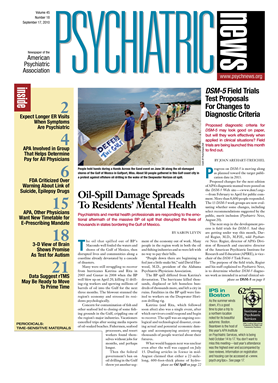Radiologists do it. Cardiologists do it. Why shouldn't technologically educated psychiatrists do it—that is, take the next step in telepsychiatry?
Emergency rooms and imaging centers routinely e-mail or upload their X-rays and scans to online sites where radiologists, who can be located anywhere in the world with an Internet connection, read them and send back a report.
Could psychiatrists do the same, at least for nonurgent cases?
Researchers from the University of California, Davis, have now tested and reported on such a system for evaluating patients with psychiatric symptoms.
They noted that key elements of medical care include data collection, data analysis (diagnosis), and treatment planning. Those are usually conducted during the same doctor/patient encounter, but could be separated in time and space, as the radiologists do.
Currently, telepsychiatry is a synchronous system, relying on real-time interaction between the patient at the remote site and the consulting psychiatrist. Asynchronous telepsychiatry involves first recording a video interview with the patient, then uploading it to a secure Web site for later review by a psychiatrist.
A feasibility trial involving 60 patients in a rural California county indicated that patients, primary care providers, and psychiatrists found that the system worked well, wrote Peter Yellowlees, M.D., and colleagues in the August Psychiatric Services.
Yellowlees is a professor of clinical psychiatry at UC Davis who has conducted extensive research in telemedicine and electronic health systems.
“We are not suggesting that this type of assessment should replace the traditional face-to-face psychiatric interview,” he said in the report of his study. “[B]ut it may be a very helpful additional process that improves access to care and expertise.”
For the trial, primary care doctors selected patients who appeared to have psychiatric problems.
A nonpsychiatrist research physician obtained informed consent and patient history, and then recorded a 20- to 30-minute interview that included the Mini-International Neuropsychiatric Interview. No additional information was obtained from other clinicians or from family members.
“The physician—actually a surgeon by background—who handled the interviews had some training in psychiatric interviewing but was at the same level as a primary care physician,” said Yellowlees in an interview with Psychiatric News.
Once it was ready, all the material was uploaded to a secure Web site and reviewed by one of two psychiatrists at UC Davis who were well versed in telepsychiatry.
The psychiatrists provided a DSM-IV diagnosis where appropriate, a Global Assessment of Functioning score, and a comprehensive treatment plan. They could order lab tests as well. Once they reviewed all the material and prepared their evaluation, they sent a written report to the primary care provider within two weeks.
“[F]eedback could be provided within 24 hours if asynchronous telepsychiatry were to become a regular clinical service,” wrote the researchers.
The psychiatrists who received the material identified 51 diagnoses of mood disorders among the 60 participating patients, 19 of substance use disorders, 32 of anxiety disorders, three of other Axis I disorders, and five of Axis II disorders. Seventeen of the patients had co-occurring disorders.
One patient with suspected psychosis was referred for a face-to-face consultation with the referral psychiatrist.
The system appeared to work well, according to Yellowlees; however, it may need some tweaking before being placed into general use, notes another experienced telepsychiatrist not involved in the UC Davis study.
The availability, training, and reimbursement of nonpsychiatrist physicians and local therapists would influence how practical such a procedure would be, pointed out Avron Kreichman, M.D., an assistant professor of psychiatry and a tele-health specialist at the Center for Rural and Community Behavioral Health at the University of New Mexico.
“Also, relying on an individually based, template exam doesn't allow for the flexibility in examinations that can occur in real time,” Kreichman told Psychiatric News.
Unfortunately, referrals for psychotherapy were not as simple as writing a prescription for medication, because not very many behavioral therapy resources are easily accessible to patients in the underserved Central Valley of California, said Yellowlees.
“We recommended whatever we thought might be possible locally, having discussed the options with the referring providers at the beginning of the project,” he said. “But not all of our recommendations were able to be carried through. A number of the patients were under- or uninsured, as well, which is a major barrier.”
Furthermore, patients with more severe, persistent, or urgent disorders or presentations were excluded from the trial, noted Kreichman. “But those are actually the circumstances in which psychiatric consultation is most strongly desired by primary care practitioners: psychosis, delirium, mania, suicidality, homicidality,” he said.
Because this was a feasibility study, no control group participated, but Yellowlees' team next plans to compare process and outcomes between asynchronous and synchronous telepsychiatry cohorts, he said.
